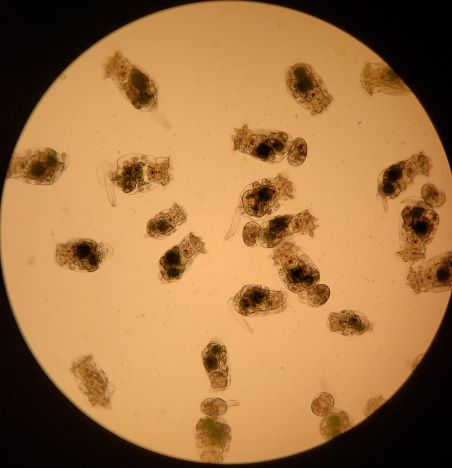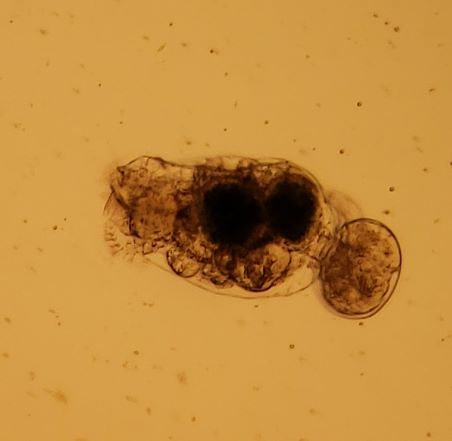Rotifers
Written by Emily Strunk October 25th, 2022
Jump to
- What are Rotifers?
- Benefits of Rotifers
- How to properly Dose Rotifers
- Storage instructions
- Culturing Live Rotifers
- Additional Information
What are they?
Rotifers are microscopic invertebrate animals typically 50 – 500 microns big. They can be found in freshwater or saltwater and come in many shapes and sizes. There are around 2000 identified species of rotifer around the Earth and many more undiscovered species. They can be found in almost every place water can be found including moss, lichen, creeks, lakes, and oceans.
All rotifers share the same basic body plan consisting of a head, neck, body and foot. A crown of cilia on the head called a corona gave rotifers their name. In Latin, rotifer means “wheel bearer” which references the spinning wheel-like corona. Rotifiers also have jaws called trophi that are used to grind up food such as microalgae. Both the trophi and the corona are the identifying characteristics that make a rotifer a rotifer. Rotifers can reproduce asexually or sexually depending on the species and environmental conditions. In good conditions, females will asexually produce eggs that will hatch into more female rotifers.
If conditions worsen, male rotifers will start being produced and will breed with females to sexually reproduce. Sexual reproduction encourages genetic mixing which can help the rotifers adapt to a new environment over time. Rotifers can live independently or form colonies of up to a thousand rotifers. If the environment becomes too inhospitable for the rotifer to survive, they can enter a resting stage called anhydrobiosis (“Life without water” in Greek) in which they shed all of the water in their body and compact into a tiny ball until the environment is safe again.
Due to their small size and simplicity in culturing, rotifers are one of the most important live feed items in the aquaculture and aquarium industry. Rotifers are used all over the world in the culturing and raising of all kinds of aquatic fish, shrimp, corals, and vertebrate and invertebrate larvae.
They are probably best known for their use in clownfish rearing as rotifers are one of the only foods clownfish fry can fit inside their tiny mouths. Using rotifers as a live food also adds another link in the food chain in your aquarium that will support a more balanced habitat and keep your tank inhabitants happy and healthy.
Introducing live food to your aquarium will provide an element of interest for your fish and corals as they can hunt both during feeding time as well as throughout the day and night to pick up any stragglers. Many live foods including rotifers, copepods, and mysid shrimp can also form colonies in your system if the conditions are right. A healthy zooplankton population can help break down detritus and extra food as well as acting as a constant food source.
The variety grown at Salty Underground is Brachionus plicatilis or the L-strain rotifer. They are a larger variety (150 - 360 microns) and ideal for both smaller mouthed larval fish such as clownfish fry as well as live corals and other reef tank inhabitants including anemones and sponges. Our rotifers are grown in 1.025 specific gravity salt water at 75°F and fed a complete diet of live nannochloropsis microalgae and Roti-RichTM liquid food that provides all of the necessary nutrients to keep your fish healthy and vibrant.
Buy Slaty Underground Live Rotifers for sale here

Benefits
- Rotifers are a beloved food of fish, larvae, and corals.
- They are often the first food given to fish larvae due to their small size (150 – 360 microns)
- Corals especially enjoy rotifers due to their small size making them easier to digest.
- Rotifers can contain 50% to 65% protein.
- They are rich in highly unsaturated fatty acids (HUFAs) when fed a diet of marine phytoplankton.
- HUFAs are essential for the growth and healthy development of young marine fish and invertebrates.
Dosing Instructions
- To feed your rotifers, simply pour directly into the aquarium or use a 50 micron sieve to collect them and rinse into the aquarium with clean saltwater.
- To target feed corals, use a pipette or turkey baster to add rotifers to the water directly surrounding the target corals.
- Feeding densities will be based on how many organisms you are trying to feed and the size of the tank. Start with smaller densities and increase the amount as needed.
- It may be helpful to turn off skimmers and/or return pumps while feeding and for 15 minutes to ~2 hours afterwards to allow your animals to find and eat the rotifers.
Storage
- Rotifers can be kept in the fridge for up to 7 days.
- They can also be used to start an at-home culture that will provide a fresh supply of rotifers when you need them.
Culturing live rotifers
- The best way to store rotifers long-term is to start a small culture.
- First, prepare a culture tank. A good culture tank is anything that can hold water and be cleaned easily. A 5-gallon bucket is one of the most popular culture tank options. Fill the culture tank with pre-mixed saltwater (1.022 - 1.026 specific gravity) and add a rigid air line. Set the air line to a light rolling bubble. This will keep your rotifers suspended in the water column.
- Sieve the rotifer mixture through a very fine sieve or net (~53 microns) and add to the culture tank. Discard shipping water.
- Rotifers do best with live phytoplankton but can also be fed with any type of Roti-Rich or equivalent. Feeding will depend on the density of the culture. The typical rule of thumb is to feed enough phytoplankton to keep the water tinted a light green. You want to keep a continuous supply of food available without crowding and polluting the water. Remember: rotifers are not nutritionally significant on their own.All of the benefits they provide to your tank comes from the food that they are fed so make sure to feed them a high quality and nutrient rich food.
- To perform a water change, pour the culture through a 53 micron sieve and rinse rotifers into fresh saltwater
Additional Information
Take a look at these additional reads for more info!

